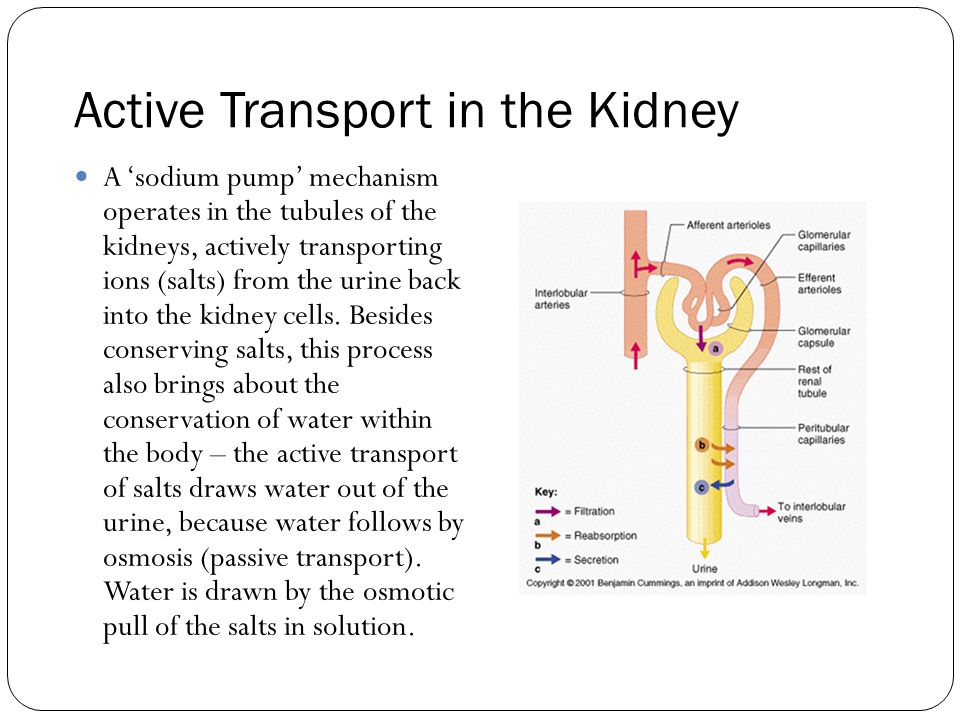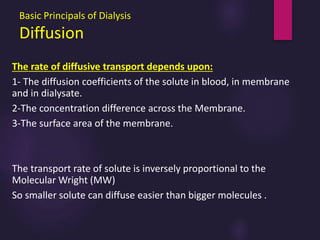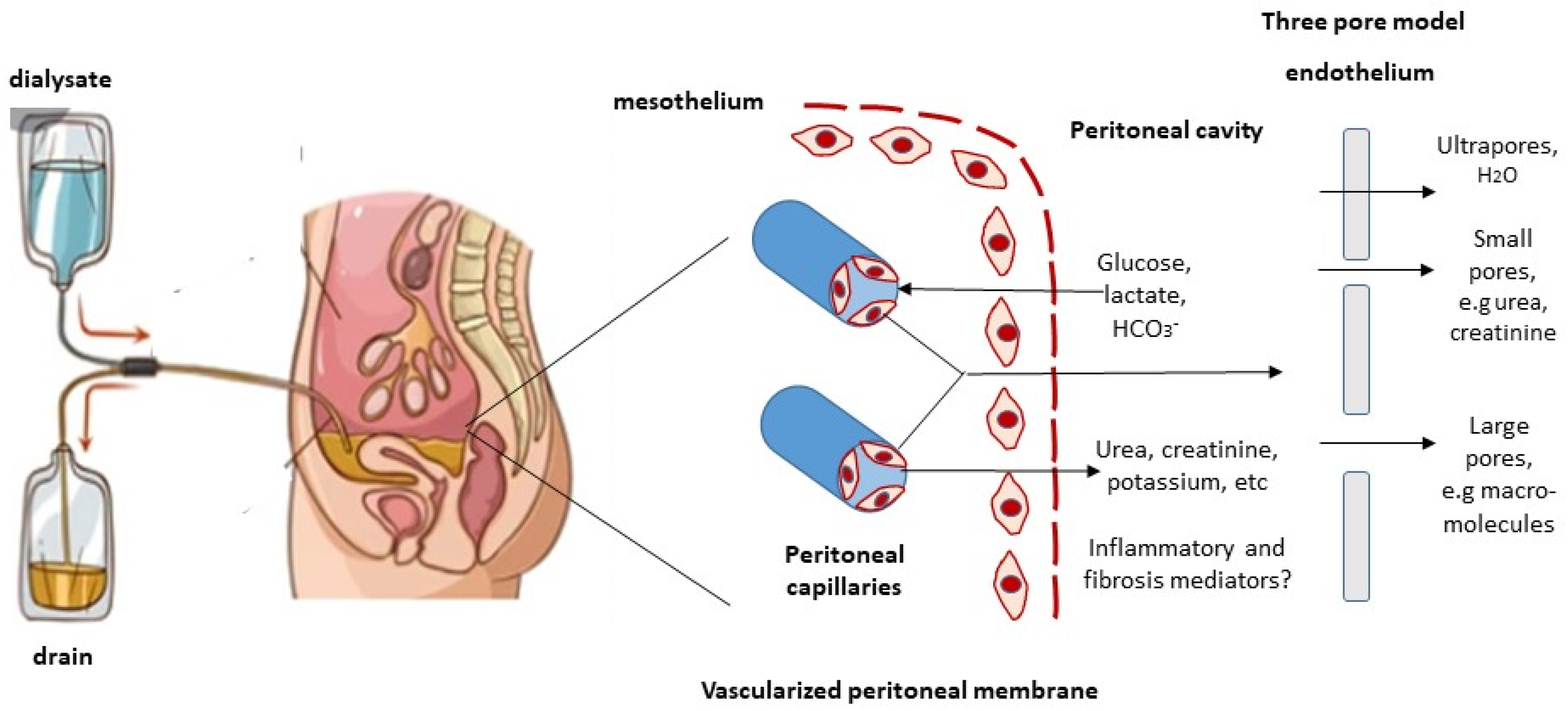Describe the General Transport Process Involved in Dialysis
Circulates the blood through the dialyzer filter which moves waste into a dialysis solution. In a dialysis machine blood from the patient runs through tubes made of a semi-porous membraneOutside the tubes is a sterile solution made up of water sugars and other.

Transport Status Classification And Implications Advanced Renal Education Program
In this type of dialysis your blood is cleaned inside your body.

. Dialysis is a procedure to remove waste products and excess fluid from the blood when the kidneys stop working properly. Returns filtered blood to your body through a different needle in your arm. The first is the solution-diffusion model 14 which was put forward 20 years ago and has been accepted mainly for explanation of the transport in dialysis reverse osmosis gas permeation and pervaporation 14.
The doctor will do surgery to place a plastic tube called a catheter into your abdomen belly to make an access. To remove blood clots and air bubbles explain why a clot and bubble trap is needed after the blood has been dialyzed but before it re-enters the body. Since small molecules have high diffusion coefficients they encounter the membrane more frequently than do large molecules.
The passive forms of transport diffusion and osmosis move materials of small molecular weight across membranes. Describe the general transport process involved in dialysis. This special fluid contains water with salt and other additives.
Kidney dialysis machines use osmosis to take over the filtering function of the kidneys 1Dialysis machines use a semi-permeable membrane which is a membrane through which some small molecules can pass such as water salts and metabolites but through which larger objects such as proteins and blood cells cannot 1Dialysis machines take the blood. This includes all types of literature and data both government and non-government available on transportation journey behaviour patterns nature and intensity of traffic freight structure cost and benefits ie income employment estimates etc. Ultrafiltration occurs by increasing the hydrostatic pressure across the.
Substances diffuse from areas of high concentration to areas of lower concentration. It soaks up waste and extra fluids inside your. This cleansing liquid contains water salt and other additives.
The blood is then pumped through the dialyzer and then the processed blood is pumped back into the patients bloodstream through another tube connected to a second needle or port. We then filled this tube with a starch solution and sealed the other end the same way. Dialysis is the process of cleaning waste products from the blood when the kidneys fail.
Youll use the catheter to transfer dialysis solution from a bag into your belly. When the kidneys are no longer able to perform their task of producing urine and filtering out the toxic substances and other byproducts from the blood it may be necessary for such patients to undergo an artificial filtering process known as kidney dialysis. Describe the general transport process involved in dialysis.
Blood flows through the fibers dialysis solution flows around the outside of the fibers and water and wastes move between these two solutions. Dialysis is a passive process that favors the transport of small molecules across a semipermeable membrane. To remove blood clots and air bubbles explain why a clot and bubble trap is needed after the blood has been dialyzed but before it re-enters the body.
Allows for removal of urea give a reason why the dialyzing solution flows in the opposite direction to the blood. During hemodialysis the dialysis machine. It is then drawn out and discarded.
This is the principal process for removing the end-products of nitrogen. Removes blood from a needle in your arm. The membranes filter waste products from your blood which are passed into the dialysate fluid.
Without dialysis all patients with kidney failure would die from the buildup of toxins in the bloodstream. Peritoneal dialysis Peritoneal dialysis involves surgery to implant a peritoneal dialysis PD catheter into your abdomen. I predict that the dialysis tubing will as a semi-permeable membrane allowing the iodine and glucose solutions to diffuse through it.
The cleansed blood is then returned via the circuit back to the body. First we sealed one end of a moist dialysis tube by tying it into a knot. Dialysis is the process of separating elements in a solution by diffusion across a semipermeable membrane diffusive solute transport down a concentra-tion gradient.
Normally the kidneys filter the blood removing harmful waste products and excess fluid and turning these into urine to be passed out of the body. The tube is connected to a 15 16 or 17 gauge needle inserted in the dialysis fistula or graft or connected to one port of a dialysis catheter. Diffusion of Iodine and starch.
It often involves diverting blood to a machine to be cleaned. Membrane fluxes in dialysis. Allows for removal of urea give a reason why the dialyzing solution flows in the opposite direction to the blood.
The dialysis machine is made up of a series of membranes that act as filters and a special liquid called dialysate. During the treatment your abdominal area called the peritoneal cavity is. A cleaning fluid dialysate is then circulated throughout the catheter that absorbs the waste materials from the blood vessels in the walls of the stomach.
In peritoneal dialysis a sterile dialysate solution rich in minerals and glucose is run through a tube into the peritoneal cavity the abdominal body cavity that surrounds the intestine. The used dialysate fluid is pumped out of the dialyser and the filtered blood is passed back into your body through the second needle. This process continues until the substance is evenly distributed in a system.
The entire planning process of transportation may be local regional or national is based on survey and data collection. A dialysis machine tries to mimic some of the functions of a human kidneyOne of the primary jobs of a kidney is to remove urea and certain salts from the blood so they can exit the body in urine. The model can also be applied in DD separation process of strong acids and alkalis.
Haemodialysis and peritoneal-dialysis are the two methods that are employed by the clinicians when a person. Peritoneal dialysis is done by surgically implanting a catheter in the stomach of the patient. The catheter helps filter your blood through the peritoneum a membrane in.

Basic Principles Of Hemodialysis Final

Membranes Free Full Text The Peritoneal Membrane Mdash A Potential Mediator Of Fibrosis And Inflammation Among Heart Failure Patients On Peritoneal Dialysis Html
No comments for "Describe the General Transport Process Involved in Dialysis"
Post a Comment